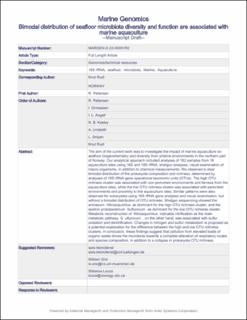| dc.contributor.author | Pettersen, Ragnhild | |
| dc.contributor.author | Ormaasen, Ida | |
| dc.contributor.author | Angell, Inga Leena | |
| dc.contributor.author | Keeley, Nigel B. | |
| dc.contributor.author | Lindseth, A. | |
| dc.contributor.author | Snipen, Lars-Gustav | |
| dc.contributor.author | Rudi, Knut | |
| dc.date.accessioned | 2023-03-07T13:36:59Z | |
| dc.date.available | 2023-03-07T13:36:59Z | |
| dc.date.created | 2022-10-20T10:20:37Z | |
| dc.date.issued | 2022 | |
| dc.identifier.citation | Marine Genomics. 2022, 66 . | en_US |
| dc.identifier.issn | 1874-7787 | |
| dc.identifier.uri | https://hdl.handle.net/11250/3056501 | |
| dc.description.abstract | The aim of the current work was to investigate the impact of marine aquaculture on seafloor biogeochemistry and diversity from pristine environments in the northern part of Norway. Our analytical approach included analyses of 182 samples from 16 aquaculture sites using 16S and 18S rRNA, shotgun analyses, visual examination of macro-organisms, in addition to chemical measurements. We observed a clear bimodal distribution of the prokaryote composition and richness, determined by analyses of 16S rRNA gene operational taxonomic units (OTUs). The high OTU richness cluster was associated with non-perturbed environments and farness from the aquaculture sites, while the low OTU richness cluster was associated with perturbed environments and proximity to the aquaculture sites. Similar patterns were also observed for eukaryotes using 18S rRNA gene analyses and visual examination, but without a bimodal distribution of OTU richness. Shotgun sequencing showed the archaeum Nitrosopumilus as dominant for the high OTU richness cluster, and the epsilon protobacterium Sulfurovum as dominant for the low OTU richness cluster. Metabolic reconstruction of Nitrosopumilus indicates nitrification as the main metabolic pathway. Sulfurovum, on the other hand, was associated with sulfur oxidation and denitrification. Changes in nitrogen and sulfur metabolism is proposed as a potential explanation for the difference between the high and low OTU richness clusters. In conclusion, these findings suggest that pollution from elevated loads of organic waste drives the microbiota towards a complete alteration of respiratory routes and species composition, in addition to a collapse in prokaryote OTU richness. | en_US |
| dc.language.iso | eng | en_US |
| dc.title | Bimodal distribution of seafloor microbiota diversity and function are associated with marine aquaculture | en_US |
| dc.title.alternative | Bimodal distribution of seafloor microbiota diversity and function are associated with marine aquaculture | en_US |
| dc.type | Peer reviewed | en_US |
| dc.type | Journal article | en_US |
| dc.description.version | acceptedVersion | en_US |
| dc.source.pagenumber | 0 | en_US |
| dc.source.volume | 66 | en_US |
| dc.source.journal | Marine Genomics | en_US |
| dc.identifier.doi | 10.1016/j.margen.2022.100991 | |
| dc.identifier.cristin | 2063119 | |
| dc.relation.project | Norges forskningsråd: 320076 | en_US |
| cristin.ispublished | true | |
| cristin.fulltext | postprint | |
| cristin.qualitycode | 1 | |
